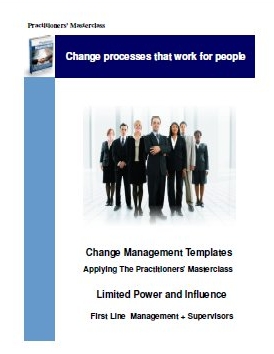Change Management Templates For Junior Managers
Managing The Transitions
 Change management templates for junior managers are about the real-life practical details of "How" to manage change.
Change management templates for junior managers are about the real-life practical details of "How" to manage change.
The "Why" is fully covered in the Practitioners Masterclass
We are going to assume that your senior management and your boss is focused on achieving the benefits of the change as quickly as possible and mistakenly assume that everyone can be “managed through the change”; and that they also believe that either it can be handled within “business as usual”; or that they do recognise that it needs to be treated as a separate initiative, but under-estimate the scope and scale of what will be involved.
As a first line manager or supervisor, you are in the firing line. It is down to you to implement their ideas.
As I am sure you are aware, the underlying cause of the 70% failure rate of all major change initiatives, is the failure to take full account of the impact of change on those people who are most impacted by it.
There are two levels of impact.
- First, there are the new ways of working, the cultural shifts, and the new processes, procedures and structures.
- Second, there are the emotional and psychological adjustments that people go through as they adjust to these new ways.
It is this emotional impact that is usually neglected. Given that people are attached to “how things are”, there is a sense of loss and emotional upheaval if that certainty, and the security it provides, is threatened.
This is important, because people cannot work effectively if they are experiencing emotional turbulence. Their ability to get work done depends on their emotions being under control. A leader has to address those often unconscious and unexpressed fears along the way, in order to help people keep them under control.
Transition management is all about seeing the situation through the eyes of the other guy - it is a perspective based on empathy, and it makes excellent business sense.
Stalling Points
- Failing to grasp that your people need to be supported and led through change
Change is an emotional business. The failing to address the human impacts of change is at the root of most failed change initiatives. It is not enough just to “manage” change; people need to be led through change
One of the major change leadership priorities is recognising and addressing the inner psychological and emotional adjustments that people move through in response to external organisational change events
William Bridges is emphatic in drawing the important distinction between organisational change and what he calls the “transition” that people need to move through in order to successfully adapt to the new circumstances arising from that change
- Misunderstanding what appears to be resistance – because:
# Transition takes longer than change
# What often seems like resistance to change is in fact people stuck in transition
# Change implementation delays are often about people stuck in transition
Critical Action Point
If you haven’t already done so, familiarise yourself with the fundamentals of William Bridges’ Transition Model
Key Questions
3 simple questions to start the process:
(1) What is changing?
(2) What will actually be different because of the change?
(3) Who is going to lose what?
What is most likely to go wrong?
- Failing to recognise and attempt to address this emotional dimension
So often it is just assumed by managers that people can and will accept an organisational change
But, the failing to recognise and attempt to address this dimension is a significant cause of organisational change failure
- Failing to realise that the larger the human impact the greater the need for transitional support
The larger the human impact of the organisational change the greater the need for some form of “transitional support”
This omission frequently [and unnecessarily] delays or jeopardises the implementation of a strategic vision and the realisation of the organisational benefits
- Your people won't "just get it"
Your people won't "just get it"; they will take at least as long as you did to transition and quite probably a lot longer
Quick metrics on progress
- There aren’t any – other than early informal feedback on your plans to address this
- The metric on your progress on transition – only becomes apparent to you by default and over time, as the change initiative matures (i.e. when you haven’t done it and you are experiencing major resistance)
Further Resources
There are 2 other key phases of your change management initiative that are identified and addressed in the change management templates for junior managers:
- Starting out
- Ongoing implementation
For more information on the 6 key steps in each of these phases please see: Change Management Templates For Junior Managers
Return to "Change management articles and resources
Home page




 Change management templates for junior managers are about the real-life practical details of "How" to manage change.
Change management templates for junior managers are about the real-life practical details of "How" to manage change.


